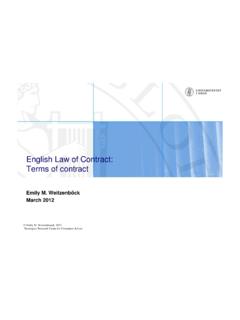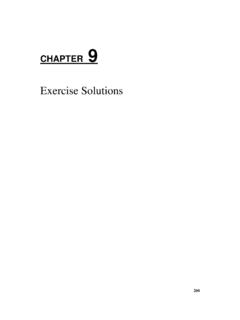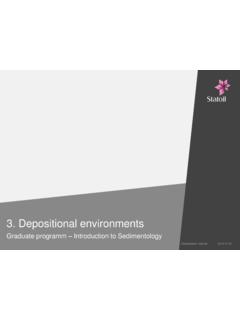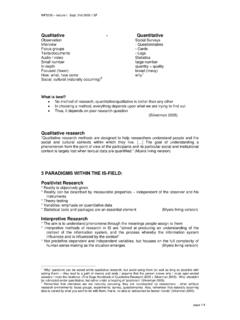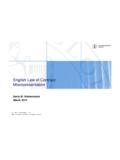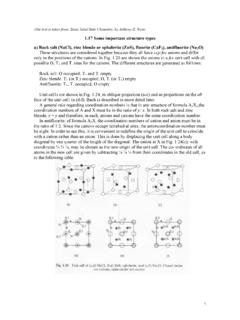Transcription of Porosity Logs - Forsiden
1 Porosity LogsGeneral Type of Porosity logs Sonic log Density log Neutron log None of these logs measure Porosity directly The density and neutron logs are nuclearmeasurements The sonic log use acoustic measurements A combination of these logs gives good indicationsfor lithology and more accurate estimates of porositySonic logGeneralSonic A log that measures interval transit time ( t) of a compressional sound wave travelling through theformation along the axis of the borehole The acoustic pulse from a transmitter s detected at two or more receivers. The time of the first detectionof the transmitted pulse at each receiver is processedto produce t. The t is the transit time of the wave front over onefoot of formation and is the reciprocal of the velocity Interval transit time is both dependent on lithologyand Porosity Sonic log is usually displayed in track 2 or 3 Units: sec/ft, sec/m Mnemonics: DT, AC Symbol: GeneralSonic Interpretation goals: Porosity Lithology identification (withDensityand/or Neutron) Synthetic seismograms (withDensity) Formation mechanicalproperties (withDensity) Detection of abnormalformation pressure Permeability identification (from waveform) Cement bond qualitySonic PorosityFormula From the Sonic log, a sonicderived Porosity log (SPHI) maybe derived: Wyllie Time-average Raymer-Hunt-Gardner For unconsolidated formations This requires a formation matrixtransit time to be known SPHI Units.
2 Percent, fraction Cp = Compaction factor C = constant, normally = matrixfmatrixlogstttt = logmatrixlogsttt85100 CtCpwith,Cp1ttttshmatrixfmatrixlogs = = Hydrocarbon effects: The Dt is increased due to HC therefore: = sx (gas) = sx (oil)Sonic PorosityChartsSonic PorosityVma(ft/sec)Vma(m/s) tma( s/ft) or mud tma( s/ft) tma( s/m) tma( s/m) - 51182 167182 or (iron)57187187 SonicSecondary Effects Environmental effects: Enlarged borehole, formation fractures, gas in the borehole or formation, or improper centralization can produce signal attenuationresulting in cycle skipping or DT spikes to higher values Improper centralization, lack of standoff, or excessive logging speed can result in road noise , or DT spikes to either higher or lower values Interpretation effects: Lithology: Porosity calculatedfrom sonic depends on the choice ofmatrix transit time, which varies with lithology Porosity calculations for uncompacted formations may yield porosityvalues higher than the actual values when using the Wyllie equation.
3 Use instead the Raymer-Hunt-Gardner equation or correct for decompaction Porosity calculated in gass bearing zones will be slightly higher thanthe actual values because the traveltime in gass is higher than in waterDensity LogGeneralDensity Gamma rays emitted from a chemical source (Ce137, Co60) interact with electrons of theelements in the formation. Two detectors count the number ofreturning gamma rays which arerelated to formation electron density For most earth materials, electrondensity is related to formationdensitythrough a constant Returning gamma rays aremeasured at two different energylevels High energy gamma rays (Comptonscattering) determine bulk density and therefore Porosity Low energy gamma rays (due to photoelectric effect) are used to determine formation lithology Low energy gamma rays arerelated to the lithology and show little dependence on Porosity and fluid type Symbol for density: (rho)High energyCompton scatteringLow energyPhotoelectric absorptionGeneralDensity Bulk Density: Units: g/cm3, kg/m3 Mnemonics: RHOB, DEN, (ZDEN) Density Porosity : Units: %, v/v decimal Mnemonics: DPHI, PHID, DPOR Density Correction: Units: g/cm3, kg/m3 Mnemonics: DRHO Photoelectric effect.
4 Units: b/e (barns per electron) Mnemonics: PE, Pe, PEF A barn is a unit of area, abbreviated mostly as "bn or b , equal to 10 28m2. Although not an official SI unit, it is widely used by nuclear physicists, since it is convenient for expressing the cross sectional area of nuclei and nuclear reactions. A barn is approximately equal to the area of a uraniumnucleusGeneralDensity Interpretation goals Porosity Lithology identification (from PEFand/or withSonic and/or Neutron) Gas indication (withNeutron) Synthetic seismograms (withSonic) Formation mechanicalproperties (withSonic) Clay content (shaliness)(withNeutron)Density PorosityFormula Formation bulk density ( b) is a function of matrixdensity ( ma), Porosity and formation fluid density ( f) Density Porosity is definedas: The matrix density and thefluid density need to be knownfmabmaden =Density PorosityChartDensity PorosityMatrix density(g/cm3)Fluid density(g/cm3)PEF (b/e) ~ ~ Effects Environmental effects: Enlarged borehole: RHOB < Fm.
5 Bulk Density (DPHI > PHIactual) Rough borehole: RHOB < Fm. Bulk Density (DPHI > PHIactual). Thisis due to the sensor pad losing contact with the borehole wall. Otherindications for a rough borehole will be highly variable Calipercurve, and a high-valueddensity correction (DRHO) Barite muds: RHOB > Fm. Bulk Density (DPHI < PHIactual) and PEF > PEFactual Interpretation effects: Lithology: Porosity calculated from density depends on the choice ofmatrix density, which varies with lithology (DPHI might be negative) Fluid content: Porosity calculated from density depends on thechoice of fluid density, which varies with fluid type and salinity. In routine calculations, zone of investigations is assumed to be 100% filled with mud filtrate Hydrocarbons: Presenceof gas (light HC) in the pore space causesDPHI to be more than the actual Porosity . In Density-Neutroncombinations, this causes a cross-over , where the NPHI valuesare less than the DPHI values In all three cases above, the RHOB value from the tool is correct, but the calculated DPHI is erroneousNeutron LogGeneralNeutron Neutron logs measure the hydrogen content in a formation.
6 In clean, shale free formations, where the porosoty is filledwith water or oil, the neutron log measures liquid filledporosity ( N, PHIN, NPHI) Neutrons are emitted from a chemical source (americium beryllium mixture). At collision with nuclei in the formation, the neutrons loses energy. With enough collisions, theneutron is absorped and a gamma ray is emitted Since a neutron is slightly heavier thana proton, the element which closelyapproximates the mass of a neutron is hydrogen. In neutron-hydrogen collisions theaverage energy transfers to the hydrogen nucleus is about that of the energyoriginally contained in the neutron. Whereas, if the scattering nucleus was oxygen(mass 16 amu) the neutron would retain 77% of its energy Materials with large hydrogen contentlike water or hydrocarbons become veryimportant for slowing down Since hydrogen in a porous formation is concentrated in the fluid-filled pores, energy loss can be related to the formation sporosityGeneralNeutron Neutron curves commolydisplayed in track 2 or 3 Displayed as NeutronPorosity (NPHI, PHIN, NPOR) Units: Porosity units ( ) (calibrated with a standard, different for all tools), v/v decimal, fraction or % Neutron logs are not calibrated in basic physicalunits.
7 Therefore, specificlogs need to be interpretedwith specific chartsGeneralNeutron Interpretation goals: Porosity (displayed directly onthe log) Lithology identification (withSonicand Density) Gas indication (withDensity) Clay content, shaliness (withDensity) Correlation, especially in casedholesNeutron PorositySecondary Effects Environmental effects: Enlarged borehole: NPHI > PHIactual Mudcake: NPHI < PHIactual Borehole salinity: NPHI < PHIactual Formation salinity: NPHI > PHIactual Mud weight: NPHI < PHIactual Pressure: NPHI > PHIactual Temperature: NPHI < PHIactualPressure and temperature have the greatesteffect. Neutron less affected by roughborehole Interpretation effects: Shaliness: NPHI > PHIactualin shaly zones Gas: NPHI < PHIactualin gassy zones. Lithology: In genera, for logs recorded in limestone Porosity units, if the actuallithology is sandstone, the log Porosity is less than the actual Porosity .
8 If the actuallithology is dolomite, the log Porosity is greater than the actual porosityPorosity CombinationsPorosity determinationGiven tma, maor ma, correct total porosities can be calculated from the appropiate logs , in water-filledformations and with no secondary Porosity * present* The Porosity created through alteration of rock, commonly by processes such as dolomitization, dissolution and Matrix lithology often unknown Complex mineralogical composition Presence of other pore fluids than water Even geometry of pore stuctures affect the toolsSo, we need additional information Fortunately, sonic, densityand neutron logs respond different on Matrix minerals Pore fluids Geometry of pore stucture Combination of logs may unravel complex matrix and fluid mixtures and therebyprovide a more accurate determination of Porosity crossplots are a convenient way to demonstrate how various combinations of logs respond to lithology and porosityIntroductionPorosity combinations When using a single Porosity measurement, lithology must be specified, through the choice of a matrix value, for the correct porosityto be calculated When using two or more measurements, lithology may be predicted(along with Porosity ), but with some ambiguity Measurement preferences (in order of choice): Two measurements.
9 NeutronNeutronand and DensityDensity QuickQuick--looklookLithologyLithologyan d and PorosityPorosity NeutronNeutronand and SonicSonic SpectralSpectraldensitydensity(bulk (bulk densitydensityand and PePe)) DensityDensityand and SonicSonic Three measurements: NeutronNeutronand and spectralspectraldensitydensity NeutronNeutron; ; DensityDensity, and , and SonicSonic MID (Matrix Identifications) Plots M-N PlotsQuick-look ( N& D)Lithology Nand DPeSandstoneNeutron-Density crossover ( N> D) of 6 to 8 Porosity units<2 LimestoneNeutron and density curves overlay ( N D)~5 DolomiteNeutron-density separation ( N< D) of 12 to 14 Porosity units~3 AnhydriteNeutron Porosity is greater than densityporosity ( N> D) by 14 Porosity units; N 0~5 SaltNeutron Porosity is slightly less than zero. Density Porosity is 40 Porosity units ( ) or more. Watch for washed out hole (highCaliper) and bad density : Both Nand Dshould be calculated with respect to limestone.
10 Nis recorded on limestone matrix and Dis calculated with a g/cm3or scaled to approx. the Neutron Porosity scaleNote: Both Nand Dshouldbe calculatedwithrespectto limestone. Nis recordedonlimestonematrixand Dis calculatedwitha g/cm3or scaledto approx. theNeutronporosityscaleNeutron-Density: Special Case Gas detection: Density Porosity is too high Neutron Porosity is too low Neutron Porosity < Density Porosity Cross-over Be aware, cross-overs may also be caused by lithologicaldifferences as an affect of the scalingDN2D2 NND32312 + + = Porosityofa gas-bearingformationSSTVD675067606770678 06790680068106820683068406850(6856) [SSTVD]Neutron-Density crossplot Advantage: Given two possible lithology pair solutions, the Porosity remainsrelatively invariant between thesolutions The combination of neutron and density is the most common of all Porosity tool pairs Disadvantage: In rough holes or in heavy drilling muds, the density data might be invalidSonic-Density crossplot Advantage.

